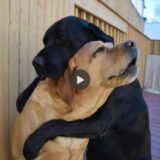Dachshunds, also known as Doxies, are a small breed of hunting dog that originated in Germany.
They are known for their long bodies and short legs, which make them easily recognizable.
These dogs have become popular pets due to their friendly nature and adaptability to different environments.
In this article, we will explore the main characteristics of the Dachshund breed and provide a comprehensive care guide for those considering adopting or buying a Dachshund.
1. Dachshund Dog Breed Overview
The Dachshund also known as the wiener dog, badger dog, doxie, and sausage dog, is a short-legged, long-bodied, hound-type dog breed.
The dog may be smooth-haired, wire-haired, or long-haired. Coloration varies.
The Dachshund was bred to scent, chase, and flush out badgers and other burrow-dwelling animals. The miniature dachshund was bred to hunt small animals such as rabbits.
| Items | Detail |
|---|---|
| Origin: | Germany |
| Size: | – Weighs: Standard: 16 to 32 pounds Miniature: up to 11 pounds – Height: Standard 15–19 inches Miniature 13–15 inches |
| Coat: | – Coat: short, wire-haired or long – Colour: solid red, black & tan, chocolate & tan, dapple, brindle or blue. |
| Life span: | 12 to 16 years |
| Main characteristics: | – Loyal and affectionate – Playful, clever, and curious |
| Suitable for: | – Great companions for families – Excellent watchdog |
Read more: Dachshund – Wikipedia

2. Care Guide
Health
Dachshunds are generally a healthy breed, but they are prone to certain health issues due to their unique body structure.
One common concern is intervertebral disc disease, which can lead to back problems.
The main cause of intervertebral disc disease in Dachshunds is their unique body structure.
The long spine and short legs put excessive stress and strain on the intervertebral discs, making them more prone to injury or degeneration.
Additionally, genetics can play a role, as certain lines of Dachshunds may be more predisposed to developing this condition.
Common signs include back pain, reluctance to move, difficulty in jumping or climbing stairs, lameness in the hind legs, and in severe cases, paralysis.
Treatment options for intervertebral disc disease can range from conservative management to surgical intervention, depending on the severity of the condition. Mild cases may be managed with rest, pain medication, anti-inflammatory drugs, and physical therapy.
Prevention and management of intervertebral disc disease in Dachshunds primarily focus on minimizing stress on the spine and maintaining a healthy weight
It is important to provide regular exercise while avoiding activities that could strain their backs.
Regular check-ups with a veterinarian and maintaining a healthy weight are crucial for their overall well-being.
Nutrition & Diet
Proper nutrition plays a vital role in maintaining the health of your Dachshund.
Choose a high-quality dog food that is suitable for their age, size, and activity level.
Due to their long bodies, it is important to prevent excessive weight gain, as it can put a strain on their backs.
Feeding them smaller, frequent meals instead of one large meal can also help reduce the risk of bloat, a condition that can be more common in deep-chested breeds like Dachshunds.
Grooming
Dachshunds have a moderate shedding level, and their grooming needs vary depending on their coat type.
Smooth-coated Dachshunds require regular brushing to keep their coat healthy and shiny.
Wirehaired and longhaired Dachshunds require more frequent brushing to prevent matting and to keep their coats in good condition.
Regular nail trimming, teeth brushing, and ear cleaning.
Related: Dog Grooming: How to Groom Dog at Home
Training & Exercises
Dachshunds are intelligent but can be stubborn at times.
Early socialization and obedience training are essential to prevent behavioral issues.
Dachshunds have a strong prey drive, so leash training is crucial to prevent them from chasing small animals.
Daily exercise is important to keep them mentally and physically stimulated. Short walks, interactive play sessions, and puzzle toys can help fulfill their exercise needs.
Related: How to Training a Dog – 10 Essential Dog Training Tips for New Owners

3. Adopt or Buy a Dachshund
If you are interested in adopting or buying a Dachshund, it is important to research to ensure that this breed is suitable for you.
| Pros | Cons |
|---|---|
| – Loyal and affectionate companions – Suitable for various living situations – Good watchdogs – Come in different coat varieties, offering options for personal preference. | – Prone to back problems and other health issues. – Separation anxiety if left alone for long periods – May not be suitable for families with young children due to their delicate backs – Require consistent grooming and regular exercise to stay healthy. |
If you’re considering buying or adopting a Dachshund for your family, there are several options to choose from.
Adoption is a wonderful way to give a deserving Dachshund a loving home. Many rescue organizations and shelters have Dachshunds available for adoption.
Additionally, reputable breeders can provide healthy and well-socialized Dachshund puppies. When buying from a breeder, ensure they prioritize the health and welfare of their dogs and have a good reputation.
4. Overview
Dachshunds are a popular breed of dog due to their friendly nature and adaptability to different environments.
They come in three different coat types and a variety of colors.
Owners should ensure that their dogs receive regular exercise, a balanced diet, and grooming to prevent health problems.
Socialization and consistent training are also important for this breed.
If you are considering adding a Dachshund to your family, be sure to do your research and provide the necessary care for this lovable breed.











